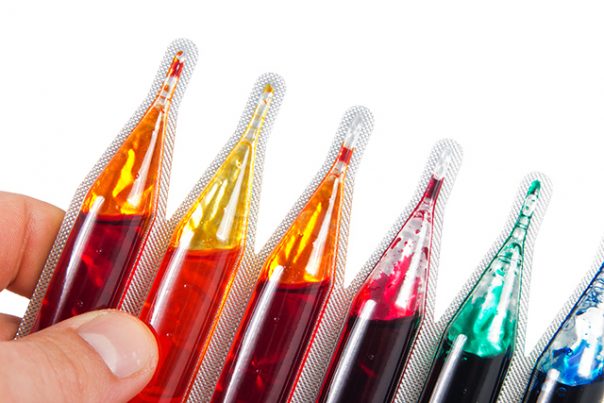
Patent Blue V – toxicity, side effects, diseases and environmental impacts
Thursday, November 23, 2017 by Janine Acero
http://www.naturalpedia.com/patent-blue-v-toxicity-side-effects-diseases-and-environmental-impacts.html

Patent Blue V, also called C.I. Food Blue 5, is a dark bluish-violet synthetic coal tar dye used as a food additive. According to UKFoodGuide.net, it has been banned in Australia, Norway, and the United States, but is permitted for use in the European Union.
Other names for Patent Blue V include C.I. Food Blue 3, C.I. Acid Blue 3, Carmine Blue V, Dai-ei Acid Pure Blue VX, Merantine Blue V, Mitsui Acid Pure Blue V, New Patent Blue A-CE Extra, New Patent Blue Extra Pure A, Patent Blue V and L, Patent Blue V Carmine Blue V, and Solar Pure Blue VX. Its molecular formula is C27H33N2O7S2.

List of known side effects
Patent blue V dye, which is now being used more often in medicine for varied indications (e.g. used diagnostically to color lymph vessels), has a potential to cause adverse reactions. It is best avoided by people with allergy reactions as it can cause skin sensitivity, rashes (similar to nettle rash), itching, nausea, low blood pressure, tremors, and breathing difficulties.
Other side effects to different levels of exposure to patent blue V include urticaria or blue hives, pruritis, or generalized rash, transient hypotension, bronchospasm (wheezing) or laryngospasm (contraction of the vocal cords that makes it difficult to speak or breathe), and severe hypotension requiring vasopressor support.
The National Institutes of Health advises that “an awareness of the time of onset and infrequency of life-threatening reactions to patent blue dye may result in better management, less postponement, more complete workup and referral of these events.”
Body systems affected by Patent Blue V
There is no current specific review made for body systems affected by patent blue V exposure. Additionally, there are no reported cases of allergy or anaphylactic reactions after ingestion of patent blue V in humans.
The Toxicology Data Network set general evaluations for chemical exposure applicable to patent blue V, such as sensory irritation (eyes, nose, skin); respiratory tract irritation that can progress to acute respiratory distress syndrome (ARDS) or acute lung injury; esophagus and gastrointestinal irritation; allergic hypersensitivity dermatitis; and asthma with bronchospasm (wheezing).
Items that can contain Patent Blue V
Typical applications of patent blue V include baked goods, beverages, confectionery, dairy fats and oils, dry mixes and seasonings, fruit preparation, meat, seafood, and snacks, among others.
How to avoid Patent Blue V
For occupational exposures, any handler, mixer and applicator is required to wear safety glasses with side shields and to NOT wear contact lenses, as they may absorb the chemicals. If the substance comes into contact with your eyes, flush it out with running water. Remove contact lenses first, if applicable.
Always wear chemical-resistant gloves to protect your hands, and wear protective overalls. Wash any contaminated area of the skin with running water in case of contact. For accidental inhalation of chemical fumes, remove the patient from the work area to an area with fresh air or proper ventilation. Seek out immediate medical attention for any emergency.
Where to learn more
Summary
Patent blue V is a dark bluish-violet coal tar dye that is used as food additive.
Patent blue V has been banned in several countries, but is permitted for use in the E.U.
Exposure to patent blue V can cause skin sensitivity, urticaria or blue hives, itching, nausea, low blood pressure, tremors, and breathing problems.
Sources include:
Tagged Under: Tags: Patent Blue V





